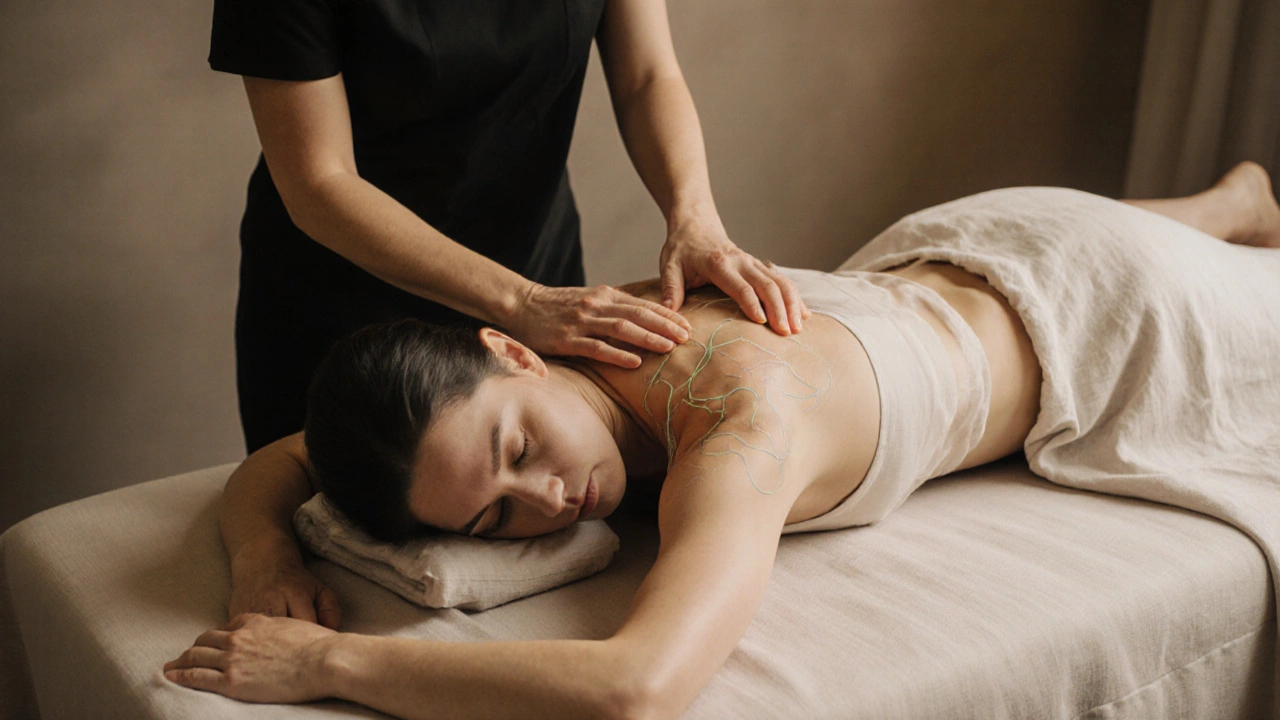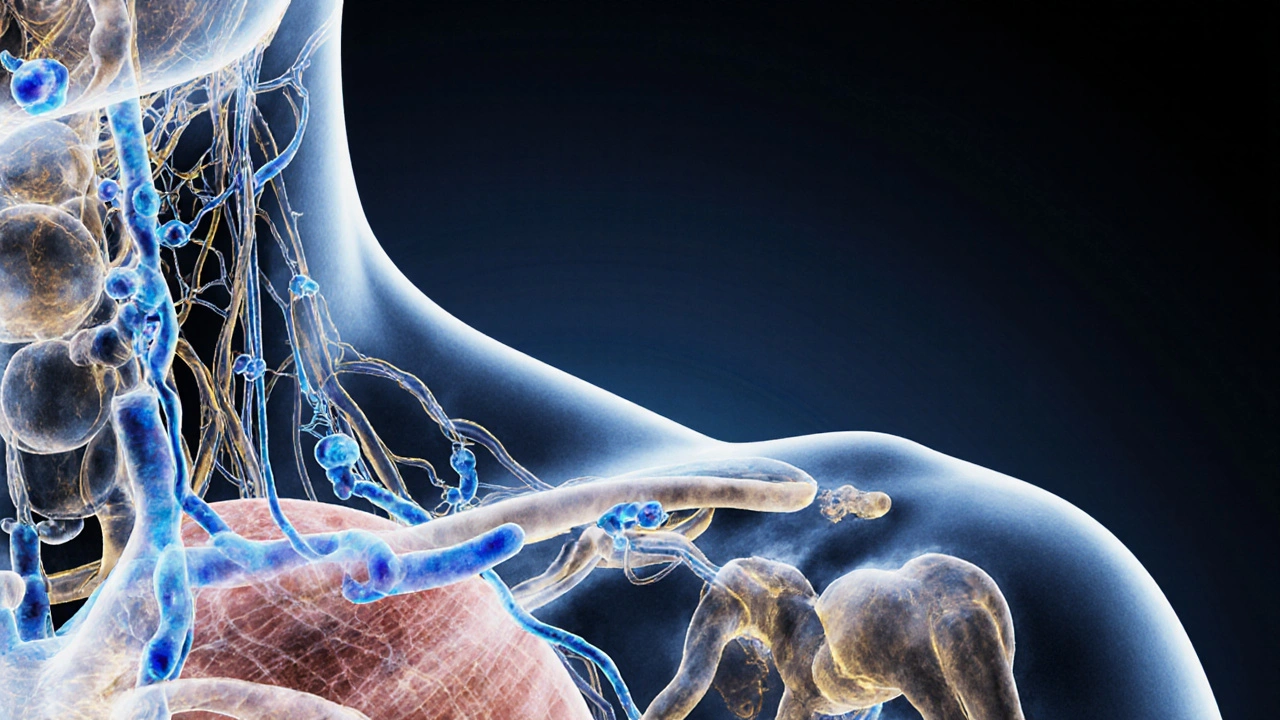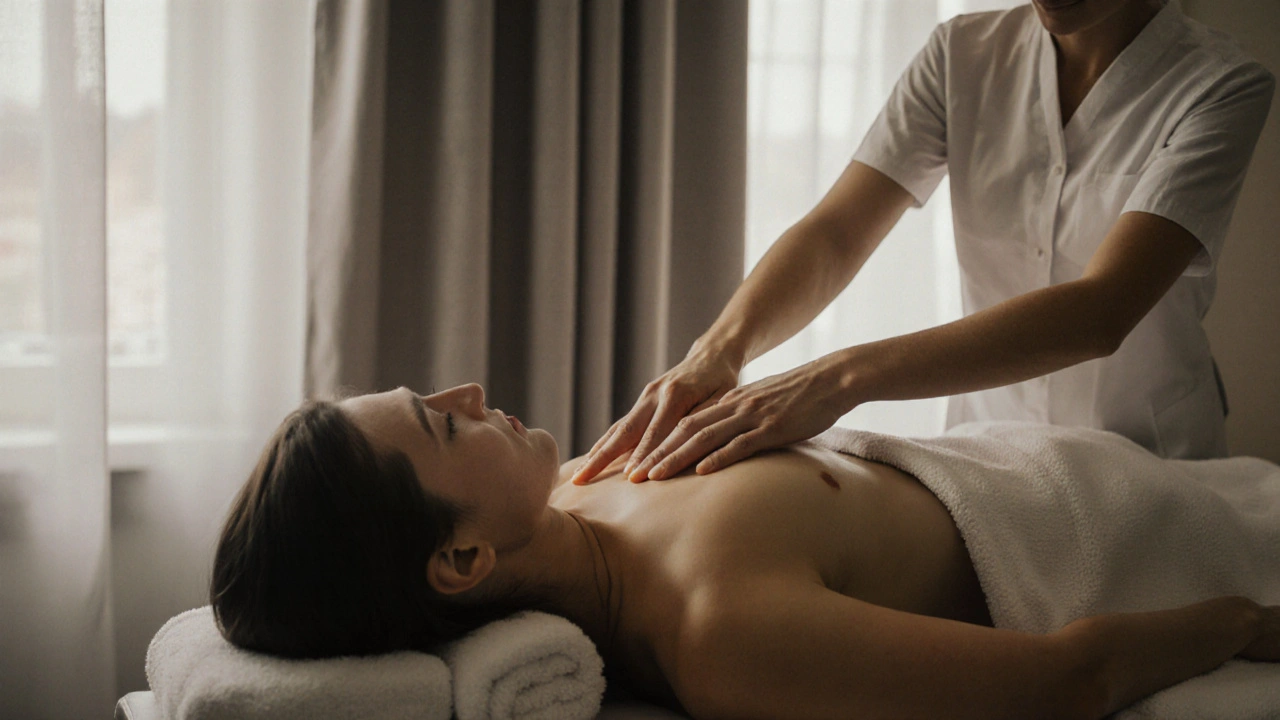How Lymphatic Drainage Massage Helps You Recover Faster After Surgery

After surgery, your body isn’t just healing-it’s fighting. Swelling, stiffness, and that heavy, sluggish feeling? That’s your lymphatic system struggling to catch up. You’ve had the procedure, you’re out of the hospital, but you’re still stuck in recovery mode. What if there was a gentle, non-invasive way to speed things up? Enter lymphatic drainage massage.
What Exactly Is Lymphatic Drainage Massage?
Lymphatic drainage massage isn’t your typical deep tissue rubdown. It’s a light, rhythmic technique-so gentle you might think it’s not doing anything. But it is. This massage targets your lymphatic system, a network of vessels and nodes that move fluid, waste, and immune cells around your body. After surgery, that system gets overwhelmed. Fluid pools where it shouldn’t, causing swelling and slowing healing.
Think of your lymphatic system like a sewer line for your body. Surgery is like a clog. Lymphatic drainage massage doesn’t force anything. It gently guides the fluid back into flow. Practitioners use feather-light pressure-about the weight of a nickel-moving in slow, circular patterns along lymph pathways. No oils, no deep pressure, no pain. Just quiet, deliberate motion.
Why It Matters After Surgery
Most people focus on pain meds and rest after surgery. But swelling is just as dangerous if left unchecked. Fluid buildup can lead to fibrosis-scar tissue forming in the wrong places. It can delay wound healing, increase infection risk, and leave you feeling tired for weeks longer than needed.
Studies show lymphatic drainage massage reduces post-op swelling by up to 40% in the first week after procedures like liposuction, breast surgery, or knee replacements. One 2023 clinical review of 1,200 patients found those who received daily lymphatic sessions returned to normal mobility 3-5 days faster than those who didn’t.
It’s not magic. It’s physiology. The massage stimulates lymphatic capillaries to absorb excess fluid, then moves it toward major nodes near the collarbone, armpits, or groin-where it’s filtered and eventually flushed out. Your body doesn’t have a pump like the heart for this system. It relies on movement. And after surgery, you’re not moving much. That’s where this massage steps in.
Benefits You’ll Actually Feel
Here’s what real patients report after just a few sessions:
- Swelling goes down visibly-your clothes fit better, your skin feels less tight
- Pain decreases, even without extra medication
- Scar tissue stays soft and flexible, not hard and raised
- Fatigue lifts. You sleep better. Your energy returns faster
- Reduction in bruising and discoloration
One woman in Amsterdam, recovering from a bilateral mastectomy, told her therapist: "I could finally breathe again. Not just my lungs-my whole body felt like it was unclenching."
These aren’t anecdotes. They’re measurable outcomes. Reduced edema means less pressure on nerves. Less pressure means less pain. Less pain means less reliance on opioids. And faster healing means you can get back to your life sooner.
When to Start-and How Often
You don’t need to wait until your stitches come out. Many surgeons now recommend starting lymphatic drainage as early as 48 hours after surgery, once the surgical site is stable. For major procedures like tummy tucks or facial reconstructions, daily sessions for the first week are common. After that, 2-3 times a week for 2-4 weeks usually does the trick.
Timing matters. Too early, and you risk disrupting healing tissue. Too late, and fluid has already hardened into scar tissue. The sweet spot? Between day 2 and day 7 post-op. Your surgeon or physical therapist should give you the green light.
Don’t try to self-massage aggressively. This isn’t DIY territory. The technique requires training. Even gentle pressure in the wrong direction can push fluid backward, making swelling worse.

What to Expect During a Session
Imagine lying on a warm table, covered lightly with a sheet. The room is quiet. The therapist’s hands move like a slow wave-never pressing hard, never rushing. They’ll start near your collarbone, then work down your arms or legs, always following the natural flow of lymph toward your main drainage points.
You might feel a slight tingling or warmth. Some people even fall asleep. There’s no music blasting, no strong scents. It’s calm. It’s slow. It’s the opposite of a typical massage.
Each session lasts 45 to 60 minutes. You’ll be asked to wear loose clothing or a gown. Afterward, you’ll feel relaxed-but not tired. Many say they feel lighter, clearer-headed, as if a weight has been lifted.
Where to Find It in Amsterdam
In Amsterdam, lymphatic drainage massage is offered by licensed physiotherapists, specialized massage clinics, and some post-op recovery centers. Look for practitioners with certification in Vodder Technique or Fliegner Method-these are the gold standards.
Areas like De Pijp, Jordaan, and Oud-West have several clinics focused on post-surgical care. Don’t just search "massage"-search for "lymphatic drainage after surgery" or "post-op physiotherapy." Many clinics now list their specialties clearly online.
Some hospitals, like AMC and VUmc, offer lymphatic massage as part of their recovery programs. Ask your surgeon if they have a referral. If you’re paying out-of-pocket, expect to pay between €65 and €95 per session. Some insurance plans cover it if prescribed by a doctor.
What to Avoid
Not every massage therapist can do this right. Avoid places that offer "lymphatic massage" as a luxury add-on to a full-body spa treatment. That’s not recovery-it’s relaxation. You need someone who understands anatomy, surgical incisions, and lymph flow patterns.
Also skip it if you have:
- An active infection or fever
- Uncontrolled heart failure
- Recent blood clots (DVT)
- Unhealed open wounds at the surgical site
If you’re unsure, check with your surgeon. A quick call can save you from a bad experience.

Lymphatic Drainage vs. Deep Tissue Massage After Surgery
| Feature | Lymphatic Drainage Massage | Deep Tissue Massage |
|---|---|---|
| Pressure | Extremely light-like brushing skin | Deep, firm, sometimes painful |
| Goal | Reduce swelling, improve fluid flow | Break muscle knots, relieve chronic tension |
| Best Time to Start | 48 hours post-op | At least 6-8 weeks post-op |
| Effect on Scar Tissue | Prevents hardening, keeps tissue soft | Can damage healing tissue if done too soon |
| Used For | Post-surgery recovery, lymphedema, bruising | Chronic pain, athletes, muscle stiffness |
| Duration of Session | 45-60 minutes | 60-90 minutes |
Deep tissue massage has its place-but not in the early recovery phase. Mixing them up can do more harm than good. Lymphatic drainage is the only massage type safe and effective during the first few weeks after surgery.
Frequently Asked Questions
Can I do lymphatic drainage massage on myself after surgery?
You can learn basic self-massage techniques after your first few sessions with a professional, but don’t start on your own. The lymphatic system flows in specific directions, and doing it wrong can push fluid into areas that are already swollen. Your therapist will show you how to gently stimulate areas like your collarbone or inner thigh after you’ve had proper training. But the first few sessions should always be done by someone trained.
How many sessions do I need after surgery?
It depends on the procedure. For minor surgeries like eyelid lifts, 3-5 sessions may be enough. For major ones like tummy tucks or breast reconstruction, 8-12 sessions over 4-6 weeks is typical. Most people notice a difference after the first or second session. Your therapist will adjust based on your swelling, pain levels, and healing progress.
Does insurance cover lymphatic drainage massage?
In the Netherlands, it’s often covered under physiotherapy if prescribed by your doctor or surgeon. You’ll need a referral and a diagnosis code like "post-operative lymphedema." Private insurance plans like Menzis or CZ usually reimburse 70-100% if it’s part of a recovery plan. Always check with your insurer before booking.
Can lymphatic massage help with scars?
Yes. Scar tissue forms when fluid and collagen pile up in one spot. Lymphatic drainage helps flush out excess fluid and encourages collagen to lay down in a more organized way. This leads to flatter, softer, less noticeable scars. Many plastic surgeons now include it in their aftercare protocols for this reason.
Is lymphatic drainage massage painful?
No. It shouldn’t hurt at all. If you feel pain, the therapist is pressing too hard. You might feel a slight tingling or warmth, but never sharp or deep pressure. Think of it as a gentle hug for your insides. Most people find it deeply relaxing-even those who usually hate massage.
How soon after surgery can I start?
As early as 48 hours after surgery, if your surgeon gives the go-ahead. For most procedures, waiting until your incision is sealed and there’s no active bleeding is key. Always check with your medical team first. Some surgeries, like abdominal procedures, may require a 3-5 day wait. Never start without approval.
Ready to Feel Lighter?
You’ve done the hard part-you had the surgery. Now it’s time to let your body heal the way it was meant to. Lymphatic drainage massage isn’t a luxury. It’s a tool. One that’s been used in Europe for decades, backed by science, and trusted by surgeons across Amsterdam.
Don’t wait until you’re stuck in swelling for weeks. Start early. Be gentle. Let your body recover properly. Book your first session. Your future self will thank you.


